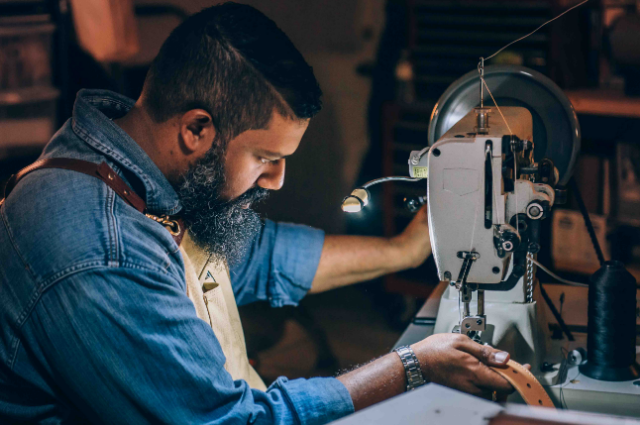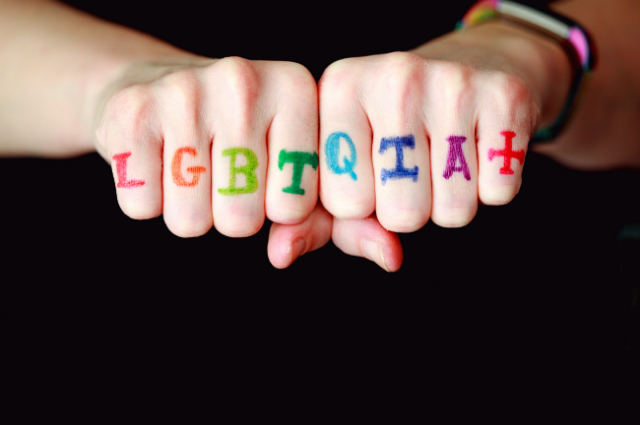As we grow up, we learn how to behave around society. This socialization process introduces the children to certain roles that are typically linked to their biological sex.
The term gender role refers to society’s concept of how people are expected to look and behave based on societally created norms for masculinity and femininity.
In the US and many European countries masculine roles are usually associated with strength, aggression, and dominance, while feminine roles are usually associated with passivity, nurturing, and subordination especially after World War I, when men being a part of the military was a matter of pride and honor.

Photo by devn on Unsplash
The above two pictures distinctively show how the different gender roles were specified by society, traditionally.
Gender role socialization begins quite early in a person's life. From the moment a kid is born, we separate the two sex based on color. A boy is always dressed up in blue and a girl in pink always. Even applying these color-coded gender labels while a baby is in the womb. A women's role is often described as the 'housekeeper' and the men are the 'breadwinner', making these notions often lead to centuries of discrimination and unequal responsibility for both genders.
Many of the gender stereotypes we know today were not always present in the past; they are relatively new trends in human society. This is because social expectations of each gender change over time, and often develop differently in cultures around the world.
Is it all traditional or new trends?
Sara Bobolts, a writer for The Huffington Post, stated how several common gender stereotypes changed over time. Bobolts describes how gender stereotypes, such as the color blue being for boys and the color pink being for girls, are new concepts. She explains that between the years 1918 and 1940, pink was viewed as a masculine color, while blue was seen as dainty and soft, making it best suited for females. Bobolts also states that during the Middle Ages in Europe, high-heels were exclusively for men, rather than women. They were seen as a “sign of masculinity”, depending on their height. This shows that the attributes people connect with “traditional” gender categories were very different only a few centuries ago, and cannot be used as a reliable basis for establishing roles today.
In an article published by Pennsylvania State University, many gender roles around the world were dictated by the environment and the needs of society. The document also states how gender roles vary based on the historical and cultural background of a society, as well as ethnicity (“The Social Construction of Gender”). For example, in many old Native American and African tribes, cultures were matriarchal, meaning that women were often leaders, healers, and important figures in their communities. This is different from most Asian and European societies, where men were the only ones with any social or political power. Therefore, depending on the period or region, gender roles vary drastically. Since these typecast based on sex are different depending on where and when they are used, they hold no real significance to human society as a whole in this modern age; they were made up and therefore can change. As a result, they should not be used as a guideline as to how people of a certain sex should behave, because they are not reliable nor constant.
Alice Eagly and Wendy Wood, authors on the psychology website APA-PsycNet.com, state that “general differences between the behaviors of the genders are the result of the social roles they were placed in”; namely those developed in the first human social structures. Nathaniel Givens, an author for Times and Seasons, also states that gender roles were not invented, but were developed over time and that they cannot work as generalized distinctions. Givens also explains how many traditional gender roles were based on the idea that parental duties should not overlap, rather, they are taken care of separately (Givens). For instance, during the Paleolithic Era and early Neolithic Era, during which most societies were nomadic tribal units, men hunted animals for sources of meat, skins, and bones, while women scavenged for roots, nuts, and berries, as well as looking after the children. These tasks held equal importance to early human societies, so both genders were viewed as equal. Over time, the technological and agricultural developments of the Neolithic Revolution spread, causing more nomadic tribes to settle down into stationary lifestyles. Thus, women began to stay home or within the settlement to take care of children, make clothes, and other domestic tasks, while men worked the fields to grow food, domesticate animals, and continue to hunt, although to a lesser scale. While children and women did tend to the fields with the men, they were often not as physically capable as the men, and thus began to be valued as less. This shows that roles were not necessarily based on gender, but rather they were based on societal needs, and, since needs remained relatively the same, they became seen as the traditional roles that men and women needed to fulfill. This demonstrates how gender roles were created based on the needs of society. However today, the majority of the jobs that are viewed as important, such as being a lawyer, doctor, politician, business executive, etc., are attainable by both sexes. This means that past gender roles should not apply anymore, because both sexes are now equally capable of contributing to society.

Photo by Alexander Grey on Unsplash
Terminology: Gender and Sex are different?
People often use the terms “sex” and “gender” interchangeably, but this is incorrect. Sex and gender are different, and it is crucial to understand why.
Judith Lorber, a professor of sociology and human studies, describes how the “gender” of a person is a “social phenomenon,” and that being a man or woman is different from being a female or male. Lorber explains that the "sex" of a person is different from their sexuality because sexual orientation, identification, and practices are socially constructed and have their specific forms of practice. Kate Gilles, the author of “What is Gender? And Why is Gender Important,” also states that sex is an anatomical term, used to describe the physical characteristics of a person, while gender is a generalization of how men and women should look and behave in society. These facts show the clear differences between sex and gender. Sex is anatomical, while gender is social and psychological. Therefore, gender should not be confined to the sex of an individual, because gender is not actually a biological occurrence.
LGBTQIA+ and society
There are a large number of different constellations of genders and sexualities that transgress traditional gender norms. These range from lesbian, gay, and bisexual, to queer, trans, and non-binary. A person’s gender identity, expression, and sexual orientation do not necessarily follow a linear pattern; a person could identify their gender as non-binary and their orientation as being attracted to men. Another person might be a transgender woman attracted to men, making her heterosexual. A third person might be cisgender and pansexual, meaning they are attracted to people regardless of gender or sex. Drawing from classic gender and development insights, if we know that women should not be treated as an essentialized, homogenous group of beings, we should not do the same for LGBTQI people, or people of diverse sexual orientation and gender identity (SOGI).
A recent discussion with my fellow friend was about LGBTQ and how the behavior is not natural to humankind. He described how men having feminine characteristics/behavior were not a feature of men, for example, moving their hands in a certain way which was feminine. These actions were a matter of confusion and influenced on the discussion of the LGBTQ community among the public. Homosexuality was a matter of concern, as they were just set up by society.
I was baffled by the statements and the arguments he made. One of the reasons for me to talk about this in an informative way. Heterosexuality and attraction towards the same sex aren't abnormal, but termed so as society has lowered its standards to such an extent.
Homosexuality prevailing in ancient India
Amara Das Wilhelm's book "Tritiya-Prakriti: People of the Third Sex", compiles years of extensive research of Sanskrit texts from medieval and ancient India, and proves that homosexuals and the "third gender" were not only in existence in Indian society back then, but that these identities were also widely accepted.
Citing from the chapter "Purushayita" in the Kama Sutra, a 2nd-century ancient Indian Hindu text, the book mentions that lesbians were called "swarinis". These women often married other women and raised children together. They were also readily accepted both within the 'third gender' community and ordinary society.
The book further made mention of gay men or "klibas", which though could refer to impotent men, represented mostly men who were impotent with women due to their "homosexual tendencies".
They (gay men) were thoroughly referenced in the chapter “Auparishtaka” in the Kama Sutra, which is to do with oral sex. Homosexual men who assumed the ‘passive’ role in oral sex were referred to as ‘mukhebhaga’ or ‘asekya’. The Kama Sutra's homosexual man could either be effeminate or masculine. While they were known to be involved in relationships of a frivolous nature, they were also known to marry each other.
The book further mentions that there were eight different kinds of marriages that existed under the Vedic system, and out of those, a homosexual marriage between two gay men or two lesbians were classified under the "gandharva" or celestial variety – "a union of love and cohabitation, without the need for parental approval".
Respect and acceptance for all
In this society, there shouldn't be any such norms discriminating against any gender. Social acceptance needs to build amongst the growing youth. The topic shouldn't be taboo and the current generation needs to make sure of that. Spreading awareness and knowledge, so that the general public is well-educated enough before making any comments about masculinity and femininity.
The wrong information is often spread in the current internet world. Influencers these days spread toxic comments and thoughts which often lead the young youth to a dark mentality. As we know these can't be removed completely, we ourselves should be aware of what is wrong and what is right.
Introducing something like gender-neutral uniforms at the school level will ingrain in the children’s minds at their developmental stage that all genders are equal and should not be subjected to any kind of discrimination.
It ensures that the upcoming generations will take India towards a liberal and progressive path finally bringing about a positive social change in the society in terms of gender equality.
When we talk about gender equality, it not just opens up dialogues about women getting equal treatment and opportunities like men, but also brings to the limelight equality to the LGBTQIA+ community as well.
Practicing gender neutrality helps to break free from the gender binary and conduct yourself the way you want. It encourages people to practice the true right to freedom and expression.

